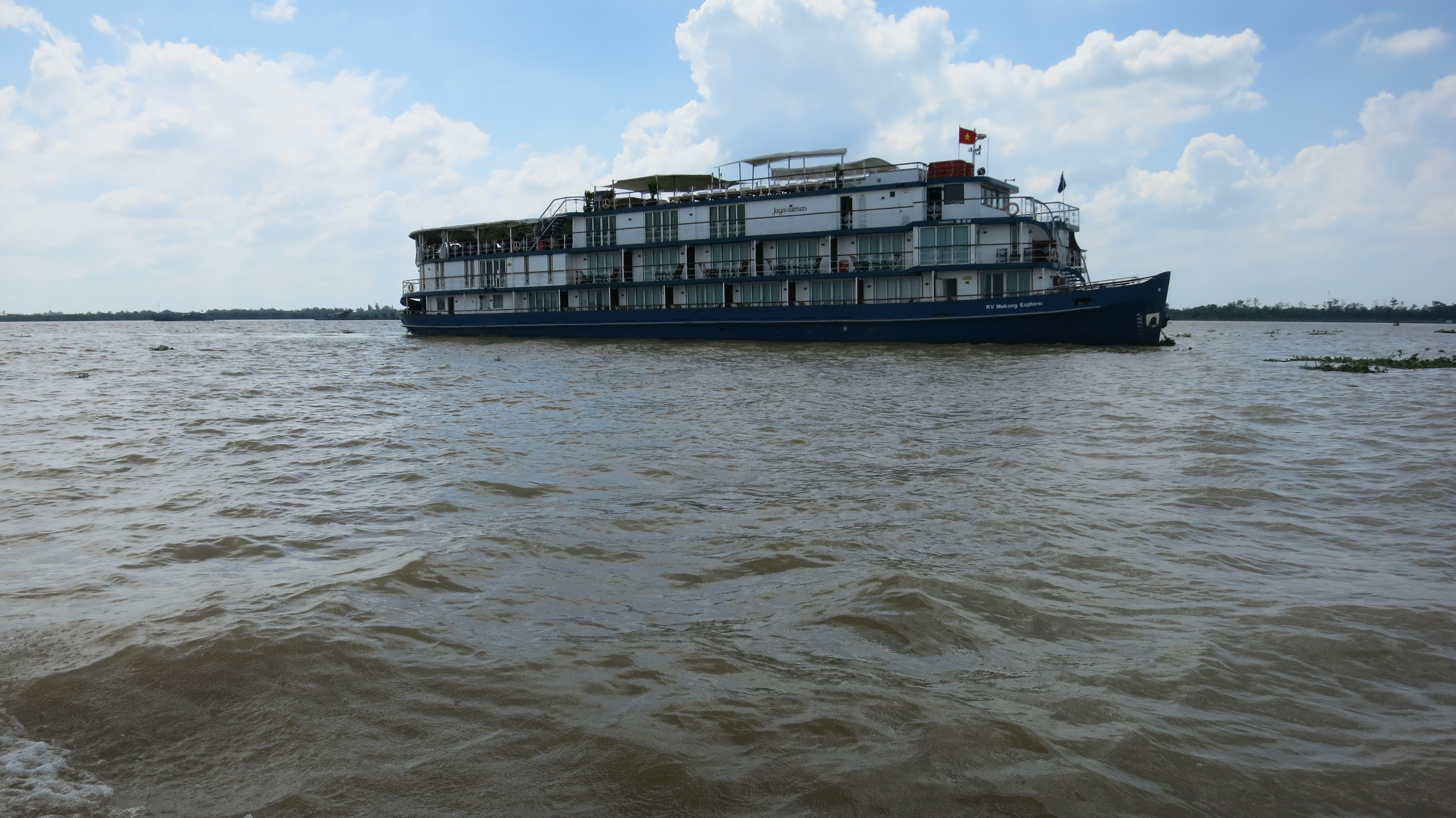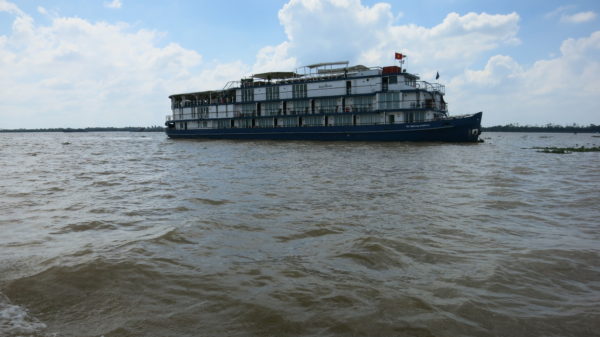
16 Nov TIO SE Asia: Dispatch 4, Blood & Diamonds
Note: Once again, it is impossible to load large files while we are on the Jayavarman. We plan to publish photo essays of the trip once we are on dry land. Meanwhile, please draw the images in your mind’s eye.
It is a story is written in diamonds and blood.

Diamonds first…
In 802 AD, Jayavarman II (the god-king for whom our boat was named) declared himself king, marking the beginning of the Khmer Empire.
The empire flourished for over 600 years, allowing successive rulers to dominate much of Southeast Asia and accumulate immense power and wealth. Deeply influenced by India, Jayavarman built monumental temples including the famed Angkor Wat, now a World Heritage Site. He also facilitated the spread of first Hinduism, then Buddhism, to much of Southeast Asia. After the fall of Angkor to Ayutthaya in the 15th century, Cambodia was ruled as a vassal state between its neighbors.
In the afternoon, our wonderfully warm and very colorful guide “Adam,” a former teacher (who wears his erudition lightly, but it shows) led us on a tour of a complex of splendid royal buildings, including the Royal Palace and Silver Pagoda, the capital city of Phnom Penh’s signature Khmer-style structures.
Roofs of the buildings on the site are adorned with golden nagas (mythic snakes, protectors); celestial dancers (apsaras) hold up the tops of the structures; glinting roofs wink at the sky. Temples are painted pale yellow (the color of Buddhism) and white (for Hinduism); gardens are manicured to unnatural, French-colonial perfection. One very long wall adorned with a fresco unrolls the story of Ramayana about the rescue of Queen Sita by King Rama’s faithful servant-monkey Hanuman.
The so-called “Emerald Buddha,” a descendent of the original but cast from jade, dominates the Pagoda, whose tiles contain about six tons of silver.
And here comes the bling, rather BLING: throughout the building, diamonds sparkle on buddhas large and small, but the so-called “Golden Buddha” wears the really big rocks: about 20 carats in his third eye; the one on his chest near his heart is about 25 carats.
Eat your heart out Elizabeth Taylor.
The original royal palace was built in 1434; the building we now ogle, the official home of King Shihamoni, an elected monarch, is less than 100-years-old. Many of the structures on the site were refurbished in the 20th century.
Figures of seven ladies dominate a small building near the Throne Room. The mannequins are tricked out in different colors: red for Sunday; yellow for Monday; purple for Tuesday; light green for Wednesday; dark green for Thursday; blue for Friday; and burgundy for Saturday.
Why different colors for the different days of the week?
According in Adam, wearing the right color on the right day brings good luck.
Wonder if the tradition also saves the king from having to check the calendar – and guarantees that his servants are wearing clean clothes everyday.
Why in the coronation hall is the king’s throne on the right; the queen (and women in general) always seated on a man’s left?
Adam explained that for centuries, when men hunted, the right arm pulled the bow or wielded the knife. Women prepared the food, stirring the pot with their left arm. When the right and left come together, happiness rules.
Plus that proves the man is Mr. Right.
Now the blood…
With much sweat and tears.
But not until after another one more poshy lunch in the poshy setting of the Malis Restaurant.
Cambodia became a protectorate of France in 1863; independence came in 1953.
Because the Ho Chi Minh Trail (the route used by the Vietcong to travel from the North to the South of the country) passed through Cambodia during the Vietnam War, the U.S. bombed Cambodia from 1969 –1973, dropping a staggering 300,000 tons of terror and destruction onto the country.
According to Dr. Jean-Michel Filippi in his late-afternoon lecture on the boat about the modern history (1953-1993) of Cambodia or Cambodge, the seeds of the Khmer Rouge were planted in the 1960s by a group of PhDs trained in Paris, including one Saloth Sar, who later took the name Pol Pot and became a paranoid murderer.
Marx and Lenin were the cadre’s twin gods.
The seeds then took root following the Cambodian coup of 1970, when the Khmer Rouge duped Sihanouk into an “alliance,” which for the deposed king turned out to be a deal with the devil.
Khmer Rouge, now an extremist national movement, spread like a cancer, taking Phnom Penh in 1975 and evacuating the city, also killing millions all over the country.
The movement, we learned from the professor, had no time for doctors, lawyers, or intellectuals of any stripe: everyone should farm the land as equals. They had no time for traditional families either, forcing strangers to marry and their progeny to be “raised” in collectives, where the kids were educated in propaganda – and spied on their own parents.
The Cambodian Genocide, a blood bath designed to exterminate any opposition, took place between 1975 –1979, when the murderers were ousted by Vietnam and the Vietnamese-backed People’s Republic of Kampuchea in the Cambodian–Vietnamese War (1979-1991).
We witnessed the devastation up close and personal the morning of November 15, when Adam led us into the heart of darkness known as the “Killing Fields,” a former Chinese burial site and rice field, where thousands of Khmer Rouge’s victims were brutally murdered after being interrogated (and horribly tortured for the names of their friends and associates) at the former school-turned-hell-hole known as S1 (for Security 1). We visited S1 too, where we were introduced to two of the seven survivors of the 17, 000 who had been incarcerated there. (There were a number of other “security” sites like that one.)
About the Killing Fields, they say the Khmer Rouge chose the location because human remains would eventually fertilize the rice fields.
Have the Cambodians forgiven the sins of the Khmer Rouge?
Forgiven, yes, Adam told us, so the country could move on.
Forgotten, no.
Or as he so eloquently summed up the idea about moving on, a saying, as I recall, his grandfather told him: “A smile makes the world change. Never let the world change your smile.”
A Buddhist trope?
Maybe.
Cambodia is, after all, a Buddhist country.
A good way to live in the world?
No doubt.
To soften the gut punch of the Killing Fields and S1, after lunch we toured the treasures of the National Museum, which houses a rich collection of relics and artifacts dating from prehistoric times to the present, its halls dominated by graceful, powerful buddhas, durgas, and bodisattvas, plus the Hindu trinity of Vishnu, Brahma, and Siva and a menagerie of strange and wonderful creatures, garrudas and more nagas, fashioned from bronze, indigenous stones, and wood.
The building designed by French archaeologist George Groslier is comprised of four linked galleries that form a rectangle around a leafy courtyard, whose roof is guarded by the ubiquitous ragas.
The grand finale of the day was ring-side seats the the country’s annual Water Festival. Our group was seated in a roped-off area reserved for foreigners only.
In Cambodia, tourism is obviously the second major industry after agriculture.
Just before we left the throngs gathered for the races – millions show up for the annual celebration – to walk back to the haven of our boat, the king’s opulent rig sailed slowly onto the scene.
Now, to put a period on Dr. Fillipi’s lecture on modern history…
Following the 1991 Paris Peace Accords, Cambodia was governed briefly by a United Nations mission (1992-1993). The UN withdrew after holding elections in which around 90 percent of the registered voters cast ballots. The 1997 coup placed power solely in the hands of Prime Minister Hun Sen and the Cambodian People’s Party, which remains in power as of 2015.
Today Cambodia has one of the best economic records in Asia, with growth averaging seven percent over the last decade. Agriculture remains the dominant economic sector, with strong growth in textiles, and construction, with tourism increasing foreign investment and international trade.
The young population – Adam told us that one out of every three Cambodians is under the age of 30, with 30 percent aged 15 – 30 – is on the march.
The pas de deux between diamonds and blood ended up back the Jayvarmaran, with a fabulous BBQ buffet served on the boat’s sundeck.
Dessert: a brilliant performance by the “Khmer Angels” who performed traditional dances, mudras reminiscent of the Buddha.


Sorry, the comment form is closed at this time.